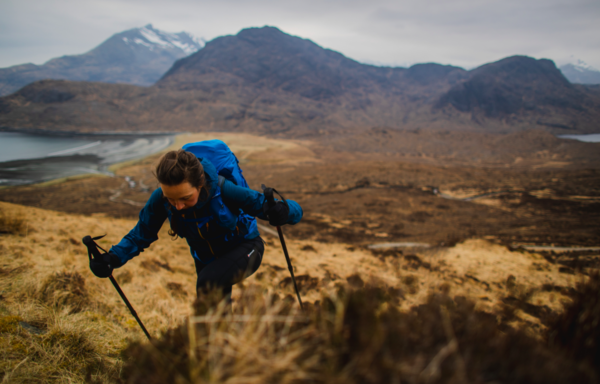How to Choose The Best Pack Back for Hiking
The right back pack can make a big difference to the comfort and distance of your adventure, making it one of the most important bits of gear you can own.
What Activity do I need my Pack for?
Most backpacks are specifically designed for their designated activity to ensure that they are as comfy, durable, and as lightweight as possible.
Day Hiking
A day hiking pack is designed just for that. Small, comfortable, and lightweight. Carry the essentials you need, like food, water, some warm clothing and a first aid kit - and you are ready to roll! Some are also good for your bike ride.
These are some of our most popular day hiking packs that come in a variety of sizes; the Osprey Tempest (womens), Osprey Talon (the mens version) and the Montane Trailblazer (comes in a few capacities depending on your needs).
Lana making friends on a day out on her bike!
Fast Packing Packs
The right pack for fast packing makes a huge difference in comfort, mobility and ultimately duration. These packs are made to be light, fit snuggly, and have a lightweight frame. They are designed to reduce bounce when loaded, a necessary feature when carrying overnight gear and running/walking long distances.
These are some of our most popular fast packing packs that come in a variety of sizes; Montane Trailblazer 30L, great in the 44L version, Ultimate Direction Fastpack and FastpackHer.

Jenny tough fast packing... learn more out fast packing here.
Overnight Hiking and Tramping Packs
These packs are generally on the larger side and are made to evenly disperse weight between the hips and shoulders. Because of the heavier weight of a large volume of gear, it’s important that these packs are fitted and adjusted to your body correctly. These kinds of packs come in a large range of sizes to use from overnighters to multi-day adventures. Some of our favourites are the following; Osprey Aura (w) and Atmos (m), Deuter Aircontact, Osprey Ariel (w) Osprey Aether (m) and also the Aarn Packs Peak Aspiration.
Winter Mountaineering and Ski Touring Packs
Mountaineering and Ski Touring packs are tougher than a regular back pack. They are reinforced to endure a bit of bashing from rocks and ice, and have special attachments for ice axes and other fun things! Often you can strap skis/snowboard/snowshoes onto the side or across the front. The design of them is also different, with special pockets for your avalanche gear.
These are some of our most popular Ski Touring and Mountaineering packs which come in a variety of sizes; Backcountry Access stash, Deuter Freerider and the Arva Explorer.
Sometimes in New Zealand, a LOT of hiking is required to earn your turns when skiing!
How to Choose What Pack Size I Need?
Now you know what type of pack you need, next you need the size! Figuring out what sized pack you need can be hard and is often the thing people get stuck tossing up between. If in doubt, bring essentials into store and try it all packed up- we really don’t mind, and you won't regret it later when you mates are trying to squeeze in the one last thing that doesn't fit!
Day Hikers (20-30L)
20 to 30 litres is usually a good size for day hikers, enough to pack up your lunch, water, extra layers and first aid kit.
Fast Packers (any where from 10L to 45L)
Fast packing really depends on how light you want to go! No tent, no luxuries and cold meals... you can go super light! But add a stove, sleeping mat and few other essentials you may need the bigger size.
Overnight Hikers (40-50L)
Overnight pack size depends on whether you’re staying in a hut or taking your tent and sleeping mat. Hut hikers can get away with a smaller pack size, campers will need a larger pack for that extra gear. Generally, between 40 and 50L is suitable for single night overnight hikes.
Multi day (60+)
Multi day backpacks usually sit in that 60-70lt sweet spot, it really depends on how long you’re going for and how bulky your gear is. A lot of newer gear is made packable and lightweight, but if you have an older, bulkier sleeping bag you may need a larger pack for those long trips.
I’ve found that a lot of people love having that little bit of extra space-- this is where packs that have a ‘plus’ come in handy. These kinds of packs will have an extended area where you can pack in more if you need to. On Deuter packs, the plus comes a top that extends upwards, adding ~10lts to the pack.

What is a Pack Harness? And what type is best?
The harness of the pack is what you adjust to get the perfect fit. With waist straps and shoulder straps it can be bit of a fiddle, but worth the care and time to get it correct.
Harnesses often adjust to help you get the perfect fit, which is the most important part. However sizing can change a lot between different brands.
A good fit in a day pack is a flushness against your shoulder and all the way down your back. The hip belt ideally will cover your hip bone, where you can do it up snug.
For larger packs, your goal is to have all the weight resting on the hips. Shoulder straps are used to get the pack to hold along your back.
Finally, watch out for pressure points around the hip belt and shoulder straps! When you are spending hours or days in a pack, those pressure points can quickly become painful.
Venting on a back pack
Venting is the air flow between your pack and your body. Good venting can reduce the sweat factor! And help keep you dry and warm, or dry and cool!
A harness that has lots of little holes and a gap harness and pack is great for ventilation. Other harnesses have directed grids around the paddling that help get air in.
Which Fabric do I need?
Fabric is another hot topic. Will all your gear get wet if it starts raining? Will it rip when you start bashing though some matagouri bushes?
Most packs are designed with a ripstop, water resistant material that is great for our New Zealand bush and crazy weather. However, some packs use lightweight, but less durable materials to get that lightweight appeal. It’s all a balance!
Some packs come with rain covers for extra protection against the elements (you can buy these too), while some have internal dry bags. My personal preference is to use separate dry bags for storing my gear inside my pack, you can get different sizes too.
Design
Hip pockets, big pockets, small pockets, top pockets. The design is all about how the pack is laid out, how easy it is to pack, and accessibility to all your things. Every brand is different, and it’s all about personal preference.
I always look for a hydration pocket for my heavy water and hip pockets for all my snacks. I am not a fan of having things tied on to the outside or hanging from my pack, as it makes it feels unbalanced. For me, having a big open compartment for easy packing is a must.
Some top tips on how to choose the best backpack for you:
- Activity: what activity are you needing a pack for?
- Size it out: it’s a great idea to lay out all the things you’d usually pack for your trip to get an idea on your ideal pack size.
- Harness: What size and type? this is often something you must go try out to see what works for you.
- Fabric types: are you looking for a hearty, strong material or are you going for the ultra-lightweight spec?
- Pack Design: what’s your most valued pocket? How do you like your pack set out? Make sure you can access you much needed items easily. Water, snacks, and a rain jacket are my easily accessible items.
Back Packing, Hiking, Tramping, Climbing, or expeditions... no matter the name of the game, getting a pack to fit so it is comfortable to help you go further and faster is the goal. Its always best to try packs on and get them fitted to you. Lucky we love fitting packs, so come on in to try some on!
Written by Lana the Back Pack Guru. Come see her to get your pack fitted!
If you thought this blog was cool, check out this one too: How to find the right camping stove for you!













Leave a comment